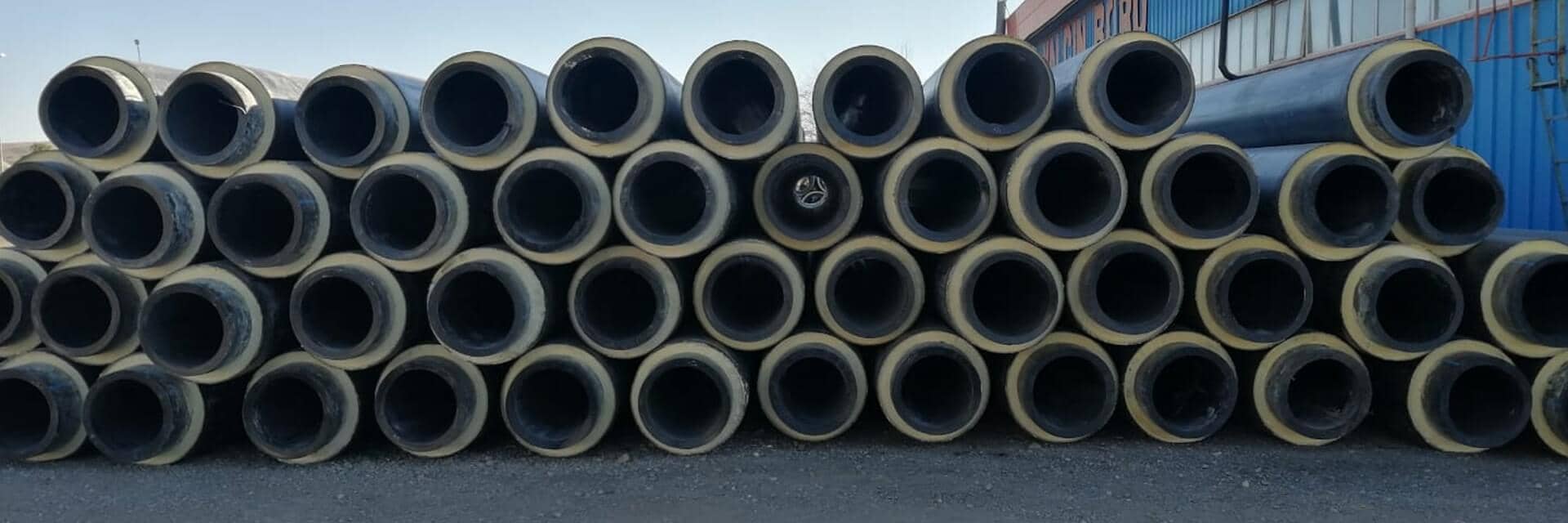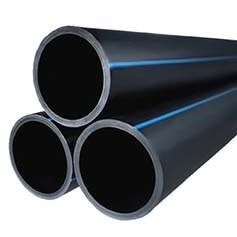
HDPE (High Density Polyethylene) pipes do not deteriorate the taste and smell of the fluid passing through them, due to their chemical properties. For this reason, it is the most suitable type of pipe to be used in drinking water pipelines and drinking water treatment plants. Although it is commonly in PN10, PN16, PN20 pressure categories, the manufacturing standards of HDPE pipes, which can be produced in various thicknesses, are as follows:
|
Manufacturing Standard |
|
TS EN 12201-2 |
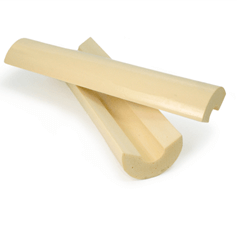
Rigid polyurethane foam is an insulation material with extremely low thermal transmission coefficient, consisting of mixing of polyol and isocyanate in certain ratios and pressure injection of these materials. PUR, which is injected between the carrier pipe and the casing pipe (HDPE), provides heat insulation as well as enabling two pipes operating as one pipe by bonding them together, and filling in the space between the pipes longitudinally. In the manufacturing of pre-insulated pipes, the PUR in accordance with the standard TS EN 253 has to meet the following minimum requirements:
Technical Specificationsr
|
Components |
Polyol and Isocyanate |
|
Minimum cellular mass density |
55 kg/m3 ISO 845 |
|
Max. Thermal Conductivity Coefficient |
0,029 W/mK ISO 8497 |
|
Average cell structure |
< 0,5 mm |
|
Closed cell content |
> %88 ISO 4590 |
|
Min. Radial Compressive Strength |
0,30 MPa ISO 844 |
|
Water absorption at high temperature |
< 10% when tested according to TS EN 253 5.3.5 |
|
Axial cutting strength |
23 °C ± 2 °C ≥ 0,12 N/mm² |
|
140 °C ± 2 °C ≥ 0,08 N/mm² |
|
|
Temperature range |
-50 °C / +148 °C |
|
Impact strength |
No damage must exist - when tested in accordance with EN 253 5.4.5 |
|
Linear Water Tightness |
Must be Watertight When tested in accordance with EN 253 5.4.6 |
|
lChlorofluorocarbon |
None |
|
Service life of insulation according to continuous service temperature |
3 years at 140 ˚C |
|
30 years at 120 ˚C |
|
|
50 years at 115 ˚C |
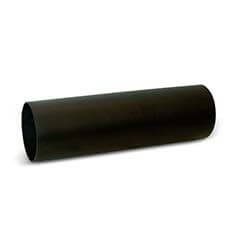
Extruded polyethylene casing pipe is used on the outermost part, which protects the insulation material from external factors and chemicals. The HDPE casing pipe manufactured in accordance with the standards TS EN 253 and TS EN 12201-2 must contain antioxidants, UV stabilisers and carbon black.
|
Standard |
EN 253, EN 12201-2 |
|
Dimensions |
EN 253 bölüm 4.3.2.2 tablo 5 |
|
Material |
PE 80 – PE 100 ISO 9080 |
|
Density |
> 944 kg/m3 ISO 1133 |
|
Thermal Conductivity Coefficient |
0,43 W/mK |
|
Thermal Stability (OIT) |
> 20 dk (210 °C) ISO 11357-6 |
|
Temperature Range |
40 °C / + 80 °C |
|
Cracking resistance under stress |
> 300 Saat (4 MPa, 80 °C) ISO 16770 |
|
Post-thermal treatment changes |
<%3 (hasar olmamalı) ISO 2505 |
|
Melt Flow Index (MFI 190°C/5kg) |
0,2 < MFR ≤ 1,0 g/10dk ISO 1133 |
|
Carbon black content |
> Kütlece % 2,5 ± 0,5 ISO 6964 |
|
Carbon black propagation degree |
<3 ISO 18553 |
|
Breaking elongation |
>% 350 ISO 6259-1 |
|
Hydrostatic Strength |
10,8 bar 80°C 165 sa ISO 1167-1-2 |
|
Inner surface treatment |
Ekstürde hattı üzerinde (on-line) corona işlemi |
|
UV Protection |
Var |
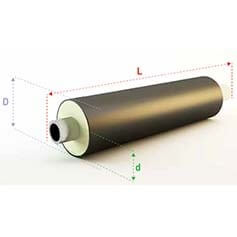
| PRODUCT NOMINAL SIZE | HDPE CARRIER PIPE**** | HDPE CASING PIPE | PUR | |||
| DN | Outer Diameterp dₐ (mm) | Outer Diameter D (mm) | Wall Thicknesss (mm) | Inner Diameter (mm) | Thickness (mm) | |
| Ø 20/75 | 20 | 20 | 75 | 3,0 | 69,0 | 24,5 |
| Ø 25/90 | 25 | 25 | 90 | 3,0 | 84,0 | 29,5 |
| Ø 32/90 | 32 | 32 | 90 | 3,0 | 84,0 | 26 |
| Ø 40/110 | 40 | 40 | 110 | 3,0 | 104,0 | 32 |
| Ø 50/110 | 50 | 50 | 110 | 3,0 | 104,0 | 27 |
| Ø 63/125 | 63 | 63 | 125 | 3,0 | 119,0 | 28 |
| Ø75/140 | 75 | 75 | 140 | 3,0 | 134,0 | 29,5 |
| Ø 90/160 | 90 | 90 | 160 | 3,0 | 154,0 | 32 |
| Ø 110/200 | 110 | 110 | 200 | 3,2 | 193,6 | 41,8 |
| Ø 125/225 | 125 | 125 | 225 | 3,4 | 218,2 | 46,6 |
| Ø 160/250 | 160 | 160 | 250 | 3,6 | 242,8 | 41,4 |
| Ø 200/280 | 200 | 200 | 280 | 3,9 | 272,2 | 36,1 |
| Ø 250/315 | 250 | 250 | 315 | 4,1 | 306,8 | 28,4 |
| Ø 315/400 | 315 | 315 | 400 | 4,8 | 390,4 | 37,7 |
| Ø 355/450 | 355 | 355 | 450 | 5,2 | 439,6 | 42,3 |
| Ø400/500 | 400 | 400 | 500 | 5,6 | 488,8 | 44,4 |
- Non-insulated pipe ends will have a length of 150 - 250 mm ±10 mm.
- Upon request, manufacturing can be made in lengths, diameters and insulation thicknesses different from the values in the table.
- Our company reserves the right to make changes on this and all other data in the brochures, written documentation and on our website. You may contact our company for getting up-to-date information.
- The wall thicknesses and unit weights of HDPE carrier pipes may vary.
PRE-INSULATED HDPE (HIGH DENSITY POLYETHYLENE) GEOTHERMAL PIPES
WHAT IS POLYETHYLENE PIPE?
Starting from 1960, Polyethylene (PE) pipes have been used for natural gas transportation in homes and workplaces. Polyethylene pipes are used in approximately 95% of natural gas distribution networks due to their high resistance to corrosion and ageing, easy transportability due to their light weight, ease of installation and assembly, and ability to last for years.
Polyethylene plastic pipes are more resistant to external impacts compared to other plastic raw material pipes. They have a flexible structure and their elongation coefficient is higher than other pipes. Thanks to these features, it can be used safely even in difficult terrain conditions. The material used can change its properties. PE pipes do not rust easily and are resistant to decay. Polyethylene pipe is a bendable material that is easy to transport and lay.
This pipe type, which is very resistant to pressure, is suitable for use in drinking water, natural gas transportation and many other areas. PE pipes have a wide range of use in irrigation water networks as well as waste water and clean water installations in homes.
With the developments in technology, there have been developments in the production of plastic pipe raw materials and plastic pipes with low-density PE 32 raw materials, which were produced in the 1950s, have become used in drinking water networks. PE 63 raw material pipes developed in the following years were successfully used in facilities that do not require high pressure. The pressure value at which PE 63 material could be used could only reach up to 4 bar. After these raw materials, materials containing PE 80 raw material appeared on the market. Pipe types containing PE 80 raw material showed high performance and became permanent products of drinking water and natural gas networks. As of the beginning of 1990, PE 100 pipe raw material was developed as the 3rd generation. These pipes have become an alternative solution in both drinking water and natural gas networks by showing high performance due to being more economical.
The strongest pipe material known today and resistant to high-pressure values is Polyethylene 100. Compared to other pipe types of the same pressure and diameter, the inner diameter of these pipes, i.e. wall thickness, is larger. As the density of polyethylene material increases, its mechanical strength also increases.
FEATURES AND ADVANTAGES OF PRE-INSULATED GEOTHERMAL HDPE PIPES
Polyethylene geothermal pipes can be used in central heating systems of buildings, air duct applications, agricultural and industrial areas. This type of pipes, which have a structure resistant to high temperatures and pressures, are very suitable for drinking water transport.
Pipes, which can be produced in different colours depending on demand, are generally white, grey, green, blue and beige. The diameter dimensions of the polyethylene pipes produced are between 20 mm and 160 mm.
PE 100 pipe type colours are blue and black. PE pipes up to 125 mm can be supplied in coils and for diameters of 125 mm and above, they can be supplied in 12-13 m lengths. In general, PE 100 pipes are manufactured in accordance with ISO 9001, TS EN 12201-2+A1 standards.
Polyethylene pipes are homogenous and non-porous pipes with smooth inner surface. Since the flow resistance is low, the pressure drop is also less. PE 100 pipes with high impact resistance also have low noise generation. The usage area of pipes with high flow rates is quite wide. Due to the quality of the raw materials in the pipes and their compatibility with current technology, the service life is also long. PE 100 pipes can be used safely by those in need thanks to the features we have mentioned. Polyethylene pipes are lightweight and simple to apply. Pipe connections are easy, fast and reliable. Since its installation is also done quickly, it saves time.
International standards are complied with in the production of PE geothermal pipes. With its non-toxic feature, they do not cause any harm to the liquid consumables carried inside.
Some of its advantages can be listed as follows;
- It is not harmful to health.
- It does not spoil the odour and taste naturalness of the transported liquid.
- Suitable for drinking water transport.
- They are recyclable products.
- It is resistant to the damages of chemical substances.
- No abrasion problem, lime retention is not seen.
- PE 100 Polyethylene Pipes have high flexing ability. Therefore, it is easy to install.
- PE 100 Pipes, which are not affected by underground movements, do not break.
- The crack propagation resistance of the pipes, which are resistant to impact, is also high.
- The inner surface is smooth. This feature leaves a movement area for diameter selection.
- PE 100 pipes, which are not affected by sea water and sea movements, are also a solution for submarine applications.
- There are no assembly losses due to joining techniques.
- At nominal operating pressure, PE 100 pipes can operate for a minimum of 50 years without any problems.
- PE 100 pipes are resistant to ultra violet rays.
- PE 100 Pipes are not affected by harmful organisms in the structure of the soil where the burial process is carried out during laying. Therefore, the protection shield (cathodic protection) used in metal pipes is not needed.
- They show resistance against harmful effects of chemical substances.
- Since PE 100 pipes are hygienic, they do not cause any change in the odour and taste of the transported water. Suitable for human health.
- Tree and plant branches and roots around polyethylene pipes cannot enter into it.
- PE 100 pipes can be produced in different pressure types and according to demand.
- It is possible to produce PE 100 pipes in coils and straight.
- Since the welding of PE 100 pipes at the joints can be done very well, no dislocation, rupture and leakage are encountered due to pressure.
USAGE AREAS OF PRE-INSULATED HDPE PIPES
- Underground and surface facilities of drinking and utility water.
- Agricultural irrigation facilities.
- Maritime sector. (Discharge)
- Discharge units of solid waste plants and waste water plants.
- Fire and cooling water plants.
- In lines used for submarine passage.
- Pharmaceutical industry and chemical industry.
- Petrochemical industry.
- Food and beverage industry.
- Maritime and fishing facilities.
- Telecommunication cable lines.
And other similar systems.
WHAT IS PRE-INSULATED HDPE (HIGH DENSITY POLYETHYLENE) PIPE?
Pre-insulated HDPE pipes are pipes containing High Density Polyethylene, i.e. High Density Polyethylene. Polyethylene used in pre-insulated HDPE pipes is a petrochemical material that is a plastic derivative and is very safe to use. HDPE (High Density Polyethylene), a thermoplastic material, has a strong, durable and flexible structure. Strong molecular bonds and insulation add impermeability to HDPE pipes. High Density Polyethylene pipes have become a great alternative to steel and concrete carrier pipes used for transporting liquids and gases. In addition, welding applications in HDPE (High Density Polyethylene) pipes; butt fusion, electrofusion, extrusion and socket welding have made HDPE ideal for many pipe applications. All kinds of liquids can be transported with pipes that have no design limitations.
Pre-insulated HDPE (high density polyethylene) pipes are the most suitable polyethylene pipes for clean water sources, especially in terms of durability and hygienic. HDPE consists of a material that can be used in many areas and is suitable for these systems. It is the most preferred pre-insulated plastic pipe material in home and commercial construction works. High Density Polyethylene pipes have almost no abrasion. Therefore, all kinds of liquids can be transported safely.
The production forms of HDPE pipes are also different in different ways. Pre-insulated HDPE pipes produced in different ways have unique features. More than one type of HDPE pipe material is available.
Pre-insulated HDPE (high density polyethylene) pipes can be classified depending on the nominal pressure rating, which is the highest pressure rating that the pipes can withstand, and the quality of the materials used. According to the quality of the material used, HDPE pipes are commonly classified between PE 63 and PE 100 (P32 pipes are also available). The higher the polyethylene value in the structure of the pipe, the higher the Required Minimum Strength, Stress Crack Resistance and Rapid Crack Progression Resistance.
Minimum Required Strength: It is the durability and resistance property that materials can show for a long time against the deterioration of its structure under permanent stress.
Slow Crack Resistance: One of the common problems that can be encountered in an underground pipe system that can remain intact for many years. High Density Polyethylene (HDPE) pipes, which contain high polyethylene, fulfil their duties safely for many years without slow cracking.
Fast Crack Progression Resistance: It is an important feature that must be present in pipes against another problem encountered in underground carrier pipe systems. Thanks to this feature, the crack that may occur for any reason can be taken under control. And with the help of this feature, the spread of the crack is prevented.
Tensile Crack Resistance: It is the feature that must be present in the material to resist structural defects that may occur under room temperature due to internal and external stresses in plastic materials.
ADVANTAGES OF USING PRE-INSULATED GEOTHERMAL HDPE PIPES IN DRINKING WATER
Throughout history, the first settlements were established close to the water sources necessary for the continuation of living life. Over time, the transmission of water resources to settlements began to be provided by canals, tunnels and aqueducts. With the increase in the possibilities offered by technology, new solutions have been developed. Today, pre-insulated HDPE pipes, one of the modern pressurised water transmission pipes, offer one of the healthiest solutions as well as many advantages. Due to the advantages provided by pre-insulated geothermal HDPE pipes, they have become pipes in the polyethylene (PE) material class and are frequently used in drinking water transmission lines. Pre-insulated steel pipes The fact that the corrosion problem seen in HDPE pipes with pre-insulation does not occur in pre-insulated HDPE pipes has made these pipes more useful in drinking water lines. In addition, these pipes used in drinking water lines are not affected by soil mobility and earthquakes thanks to their high flexing capacity, and provide an advantage of use as they are light in weight. Pre-insulated HDPE pipes do not cause deterioration in the taste and odour of drinking water and their use is suitable for health.
ARE PRE-INSULATED HDPE PIPES RESISTANT TO SUNLIGHT?
It is not suitable for pre-insulated HDPE pipes to be exposed to sunlight for a long time. For this reason, if the waiting time will be long during stock and installation, pre-insulated HDPE pipes should be stored properly. However, the varieties of pre-insulated HDPE pipes produced using UV additives are resistant to sunlight.

